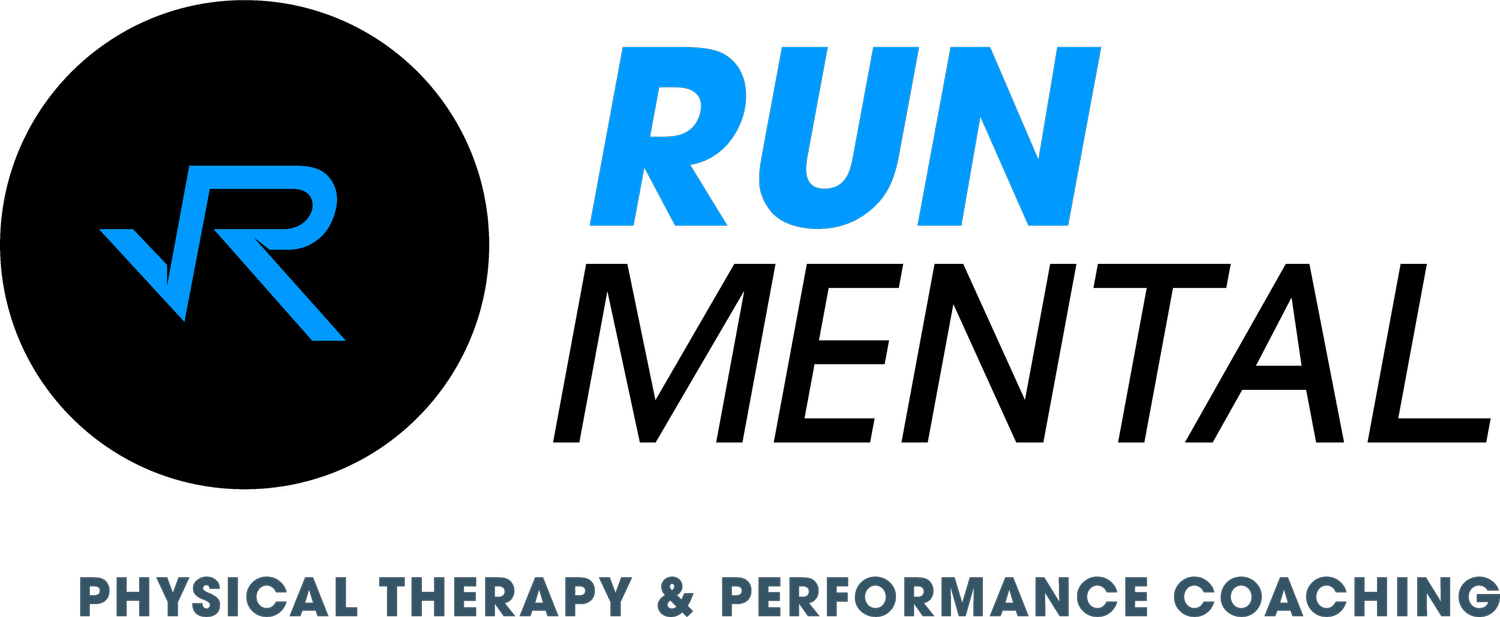Patellofemoral pain solutions for runners
Originally posted in the Pikes Peak Road Runners October 2022 issue of The Long Run
Patellofemoral pain (PFP) presents as a dull ache on and/or around the patella (knee cap) in most cases. It is a diagnosis of exclusion, meaning that all other things are ruled out prior to intervening under the assumption that the pain is related to the patellofemoral joint (PFJ).
In most cases, a large spike in training loads relative to previous weeks and months precedes the onset of symptoms. This most frequently involves vertical gain and even more so vertical loss in training as the primary variable. Often, symptoms don’t occur until several weeks after the spike which can make it difficult to pinpoint what happened. Therefore, keeping a training log can be very beneficial, as you or your healthcare provider can review it to see if your training habits were a contributing factor. I find it incredibly useful when to have access to a patient’s Garmin or Strava data in real time for analysis.
An increased workload results in a change in metabolic activity and an increase in water content in and around the joint. These changes disrupt the homeostasis of the joint, leading to an increase in sensitivity with further loading. (Dye 2005)
Despite the complexity of pain and the difficulty of diagnosis, there are some relatively easy interventions that you can try at home before seeking help from a medical professional.
Quadricep and lateral hip strengthening (Kooiker 2014, Chiu 2012, Rathleff 2014, Lack 2015)
Strengthening your quadriceps is good in itself, but two related benefits can help to restore tissue quality and decrease sensitivity. First, with progressively loading, there is an increase in the health of the articular cartilage (joint surface) of the PFJ leading to a decrease in the metabolic activity around the joint that initially sensitized it. Second, quadricep strengthening appears to increase the contact area of the PFJ. This may sound like a bad thing at first, but it aids in spreading out the force while loaded so that at any given location within the PFJ, there is less force. It is akin to the difference between pressing into your thigh as hard as you can with your thumb and using your whole hand. Try it out for yourself! Some good exercises to consider are knee extensions with a machine and partial squats or some variation.
Strengthening the lateral hip also appears to be beneficial. This would include the gluteus medius, gluteus minimus, and tensor fascia latae muscles. Note that a lack of muscle performance or strength in the hip does not appear to be a cause of PFP, but a result of the development of pain. Therefore, this strengthening to restore function than to prevent or manage symptoms. Remember, an episode of PFP is often precipitated by an acute spike in training load relative to prior weeks and months that overload the tissues faster than they can adapt. Some good exercises to consider are side planks, nearly any single leg exercise, and lateral toe taps. I have demonstration videos of many exercise options on my YouTube channel
Increasing cadence (Heiderscheit 2011, Lenhart 2014, Wilson 2015)
Cadence might be the thing I most frequently recommend adjusting, as changes in gait can aid in producing decreased stress on the knee. This is incredibly beneficial to improve tolerance to the demands of running thus allowing some level of running through the rehab process.
When you seek to increase your cadence you first need to know your baseline. If you’re using a GPS watch it is more than likely picking up the data for you, so you can look it up on the app of your watch company or Strava. If you don’t have one, no worries. You can count your steps take by one foot in a 30sec window and multiply by 2 to get the number per minute. Then multiply by 2 again to include the other foot.
Now that you have your baseline, aim to increase by at least 5%, but no more than 10%. Remember to make small progressive changes at a time. This level of increase will bring the foot closer to landing directly underneath your center of mass, creating less of a braking force and decreasing load on the knee. It will also tend to cause you to adopt a less prominent heel strike if that is your preferred pattern. There is nothing inherently wrong with a heel strike, but it does shift loads upstream. By shifting it back down a little we can bias more load to the foot and calf, thus decreasing load on the knee and improving tolerance for running.
Adopting a quicker cadence can be tricky at first for some. One easy approach is to download a metronome app to your phone and synchronizing your foot strike with that.. Spotify also has playlists at various beats. This cadence change may seem more challenging from an energy standpoint though you will adjust in a timely manner. Finally, your pace per mile should remain relatively consistent with your previous running pace even though the feet are turning over faster. In other words, your stride length should decrease to achieve the above-mentioned benefits.
Uphill running/power hiking (Baggaley 2020)
In the first article of this series, I noted that running downhill creates increased demand for our musculoskeletal system compared to running flat ground. Just as a descent with a 5% grade increases load on the knee by 50%, going up that same hill reduces load to the knee by 50%! For this reason, uphill work can be very advantageous in keeping you running and fit through the rehab process.
Depending on your fitness level, uphill running may not be an option and you’ll have to power hike. This is okay as doing something is always better than nothing and will set you up better for long-term success.
The best place to do this is on a treadmill, unless you have someone to pick you up at the top of a climb. The treadmill can eliminate the downhill completely and puts you in complete control since you can step off at any point. Additionally, it becomes easy to progress or regress as needed, as you can easily manipulate the pacing and degree of incline.
I regularly use these three interventions when working with runners who are dealing with PFP. They are easy to implement on your own and you can adjust the exercises as things improve. But please remember that no intervention can guarantee success. Each person’s pain experience is unique, and there may be other pieces to the puzzle. Particularly with recurring episodes. However, I hope that if you have PFP, these exercises will help you get back to full training quickly. If not, reach out to a trusted healthcare professional for help.
If you have questions or would be interested in working with me to help with an injury you’re dealing with, I would be happy help! You can check out out page on our physical therapy services here. You can also schedule a free phone consultation with the button below.
Happy Running!
References:
Dye S. The pathophysiology of patellofemoral pain: a tissue homeostasis perspective. Clin Orthop Relat Res 2005;(436):100-10
Kooiker L, Van De Port IG, et al. Effects of physical therapist-guided quadriceps- strengthening exercises for the treatment of patellofemoral pain syndrome: A systematic review. J Orthop Sports Phys Ther. 2014;44(6):391-B391.
Chiu JK, Wong YM, et al. The effects of quadriceps strengthening on pain, function, and patellofemoral joint contact area in persons with patellofemoral pain. Am J Phys Med Rehabil. 2012;91(2):98-106.
Rathleff MS, Rathleff CR, et al. Is hip strength a risk factor for patellofemoral pain? A systematic review and meta-analysis. Br J Sports Med. 2014;48(14):1088.
Lack S, Barton C, et al. Proximal muscle rehabilitation is effective for patellofemoral pain: A systematic review with meta-analysis. Br J Sports Med. 2015;49(21):1365- 1376.
Heiderscheit B, Chumanov E, et al. Effects of step rate manipulation on Joint Mechanics during Running. Med Sci Sports Exerc. 2011; 43(2): 296–302
Lenhart RL, Thelen DG, et al. Increasing running step rate reduces patellofemoral joint forces. Med Sci Sports Exerc. 2013;46(3):557-564.
Willson JD, Ratcliff OM, et al. Influence of step length and landing pattern on patellofemoral joint kinetics during running. Scand J Med & Sci Sports. 2015;25(6):736-743.
Baggaley M, Vernillo G, et al. Step Length and Grade Effects on Energy Absorption and Impact Attenuation in Running. Eur J Sport Sci 2020;20(6):756-766


